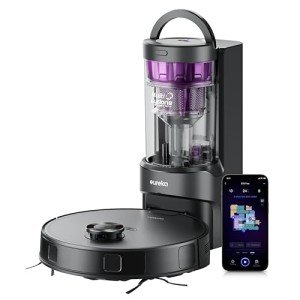The Three Greatest Moments In Robot Vacuum Cleaner History
The Rise of Robot Vacuum Cleaners in Industrial Settings
Over the last few years, the landscape of industrial cleaning has actually seen a significant transformation with the intro of robot vacuum. These automated devices are not simply a novelty for homes; they have gotten traction in warehouses, making plants, and other industrial environments. This short article explores the functionality, advantages, and considerations of robot vacuum within the industrial context, while addressing some regularly asked concerns.
What are Robot Vacuum Cleaners?
Robot vacuum cleaners are automated cleaning devices geared up with sophisticated sensing units and innovation that allow them to navigate around areas, detect dirt, and vacuum surface areas without direct human intervention. In industrial settings, they are developed to deal with a variety of particles types, help with routine cleaning schedules, and enhance overall functional efficiency.
Table 1: Key Features of Industrial Robot Vacuum Cleaners
Function
Description
Navigation
Utilizes LiDAR or camera-based navigation for accurate mapping.
Size and Design
Compact and robust design to suit tight areas and hold up against difficult environments.
Self-Charging
Immediately go back to its docking station for recharging.
Dustbin Capacity
Bigger dustbin suited for industrial particles sizes and volumes.
Shows
Can be set for scheduling and particular cleaning jobs.
Data Collecting
Geared up with sensing units to gather information for maintenance and cleaning analysis.
Advantages of Robot Vacuum Cleaners in Industrial Settings
The adoption of robot vacuum comes with a myriad of benefits:
Increased Efficiency:
- 24/7 Operation: Unlike human cleaners, robots can run around the clock, adding to constant cleanliness without downtime.
- Time-Saving: Automated cleaning permits workers to concentrate on core jobs rather than cleaning duties.
Cost Savings:
- Labor Costs: Maintaining a robot vacuum can decrease the need for a large cleaning personnel, reducing total labor costs.
- Functional Efficiency: With improved cleanliness and decreased downtime due to maintenance problems, companies can conserve on functional expenses.
Enhanced Safety:
- Reduced Risk: By minimizing the human involvement in hazardous cleaning environments, the danger of mishaps is decreased.
- Constant Cleaning: Robot vacuums ensure that areas are consistently cleaned up, reducing slip dangers and unhealthy environments.
Increased Flexibility:
- Customizable Cleaning Routes: These makers can be programmed to tidy particular areas or floors, adapting to altering industrial designs.
- Range of Surfaces: Industrial robot vacuums can deal with numerous floor covering types, from concrete to tiles, making them versatile.
Ecological Impact:
- Sustainable Cleaning Solutions: Many models utilize very little water and ecologically friendly cleaning options, aiding in corporate sustainability efforts.
Table 2: Industrial Applications of Robot Vacuum Cleaners
Market
Application
Production
Cleaning production lines and assembly areas.
Warehousing
Preserving clean and organized storage areas.
Food Processing
Guaranteeing tidiness in sensitive locations to satisfy health requirements.
Pharmaceuticals
Keeping ultra-clean environments for production.
Logistics and Distribution
Keeping paths clear for efficient operation.
Challenges and Considerations
While the advantages are considerable, organizations ought to likewise think about a number of challenges:
- Initial Investment: The in advance expenses of acquiring industrial robot vacuum can be significant, though long-lasting cost savings may offset this cost.
- Upkeep and Repairs: Regular upkeep is vital to keep the robotic systems functioning optimally, and repairs can sustain additional costs.
- Integration: Businesses might require to integrate these machines into existing workflows, which can require time and change.
- Training and Support: Staff might need training to successfully handle these machines, especially when troubleshooting or shows is required.
FAQs About Robot Vacuum Cleaners in Industrial Settings
1. Just how much do industrial robot vacuum cost?
The cost can range from a couple of thousand to tens of countless dollars, depending upon requirements, functions, and brand.
2. What kinds of surfaces can they clean up?
Robot vacuum cleaners appropriate for numerous surfaces including carpets, tiles, concrete, and even some wooden floorings.
3. How do they browse intricate industrial environments?
A lot of industrial robot vacuums utilize sophisticated navigation systems like LiDAR, cameras, and sensors to map out and adjust to their surroundings for efficient cleaning.
4. Can they clean up large areas without human intervention?
Yes, industrial robot vacuums are designed to clean comprehensive areas with preset paths and schedules, successfully running autonomously.
5. Are these robots ecologically friendly?
Lots of designs prioritize efficiency and lower water use, making them a more eco-friendly cleaning choice compared to conventional methods.
The intro of robot vacuum cleaners into industrial environments symbolizes an impressive advancement in cleaning technology. With robotic vacuum cleaner sale to improve performance, decrease labor expenses, and preserve security, these automated systems are paving the way for smarter and cleaner industrial operations. While difficulties may exist, the long-term advantages and technological advancements are motivating for industries looking for to enhance their cleaning procedures. As innovation continues to develop, we can anticipate additional innovations in robot vacuum cleaners that will transform industrial cleaning practices a lot more.
